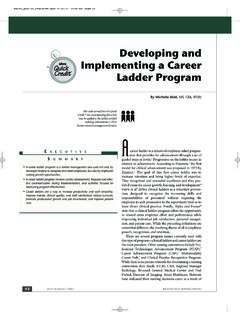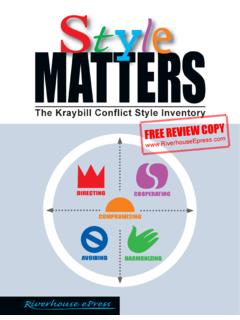Transcription of Conflict Management: A Literature Review and Study
1 September/OctOber 2014 radiOlOgy management14 Conflict at work is certain; however, the result may be influenced by the manner in which the Conflict is The volume and intensity of impending Conflict is determined by how the Conflict is Effective Conflict management encourages enthusiasm, boosts morale, and stimulates individual and organizational development; while ineffective Conflict management pro-duces more Conflict and destructively effects the whole Effective Conflict management involves the use of an assortment of styles dependent on the conditions of the article provides an overview of Conflict management strategies through a Literature Review .
2 A Study was then con-ducted of 219 radiologic technologists to predict commonalities in Conflict man-agement styles in this particular cohort, taking into account education level. Radiologic technology students who will someday become leaders in the field must know how to effectively manage Conflict situations. Possessing a higher level of education can play a vital role in helping employees handle work associ-ated ReviewConflict management strategies are the behavioral methods used to resolve These behaviors are a conse-quence of both external circumstances and the individual s own method of interaction with people and problems, and are chosen dependent upon the relative significance of one s concern for self.
3 Versus concern for Manage-ment of Conflict is extremely important for the effective functioning of organiza-tions and for the personal, cultural, and social development of human The manner in which the Conflict is man-aged typically causes more tension in the situation rather than the Conflict Any professional who is concerned with supporting others and the organization in changing negative Conflict situations should have an objective of inventive and productive Conflict management. According to Thomas and Kilmann s MODE instrument there are five modes to dealing with Conflict along two dimen-sions of behavior (see Figure 1).
4 5 The five modes are: competing (assertive and uncooperative), collaborating (assertive and cooperative), compromising (falls By Sally Erin Howell, MSRS, RT(R) Conflict Management: A Literature Review and Study Management of Conflict is extremely important for the effective functioning of organizations and for the personal, cultural, and social development of individuals. The manner in which the Conflict is managed can cause more tension in the situation rather than the Conflict itself. This Literature Review analyzes five modes to dealing with Conflict along two dimensions of behavior: compet-ing (assertive and uncooperative), accommodating (unassertive and cooperative), avoiding (unassertive and uncooperative), compromising (falls into the middle), and collaborat-ing (assertive and cooperative).)
5 In a Study , technologists preferred a cooperating Conflict management style when feelings have not yet esca-lated, and a compromising Conflict management style after the Conflict has become heated. The Study also showed education level did not have any effect on their preferred Conflict management SummaryThe credit earned from the Quick CreditTM test accompanying this article may be applied to the CRA human resources (HR) management September/OctOber 2014authority or influence by the use of open When dealing with this type of strategy frustration, irritation, or argument may be used; and conflicting parties may be fully removed from the situation by use of authority.
6 The con-flict could be temporarily lessened when competing tactics are used, but no final resolution is ever agreed upon. Com-petitive tactics are a win-lose situation, where one individual tries to pressure the other to kraybill Conflict Style Inven-tory refers to competing as a directing Conflict management strategy. When the individual uses a directing Conflict management style there is a high focus on the agenda ( Conflict ) and a low focus on the relationship with the other party. The directing style has an I win and you lose approach.
7 When individuals use this style they more than likely hold some type of power over the other party involved and are able to demand for the Conflict to be resolved in their favor. The directing approach is not always a bad Conflict management style, it can be use-ful in emergency situations when deci-sions need to be made fast. When this style is used by a supervisor it gives the employee a sense of stability to know that their supervisor is constant in their deci-sion making. CollaboratingCollaborating involves finding a solution to the conflicting situation that satisfies both An effort has to be made to actively pursue effective problem solving actions in order that all parties can accomplish equally satisfying results (win-win).
8 8 In this strategy, individuals seem to be just as concerned with the wants of others as their own; however, they are not willing to give up their own positions to merely soothe the wants of other individuals. Innovative ideas often emerge when people use the collabora-tive approach to Conflict management. When parties must continue to work together after a Conflict has occurred, a collaborative Conflict management strat-egy must be used to continue to work COMPETINGCOLLABORATINGU ncooperativeCooperativeCooperativenessAV OIDINGACCOMMODATINGCOMPROMISINGA ssertivenessUnassertiveAssertiveFigure 1 Five Methods of Managing ConflictFigure 2 Five styles of Responding to ConflictDirectingCooperationAvoidingHarm onizingCompromisingFocus on relationshipFocus on agendainto the middle), avoiding (unassertive and uncooperative)
9 , and accommodat-ing (unassertive and cooperative). Kray-bill developed a scale similar to that of Thomas and Kilmann (see Figure 2).7 kraybill s five responses to Conflict are directing (high focus on agenda, low focus on relationship), cooperating (high focus on agenda and relation-ship), compromising (medium focus on agenda and relationship), avoiding (low focus on agenda and relationship), and harmonizing (low focus on agenda, high focus on relationship). This Literature Review will follow Thomas and Kilmann s MODE instrument due to the majority of past studies using their competing Conflict management strategy is seen when individuals fol-low their own needs and goals to the exclusion of Individuals who use a competing strategy try to increase Conflict Management: A Literature Review and StudySeptember/OctOber 2014 radiOlOgy management16together in agreement.
10 A collaborative strategy is positively linked to commu-nication satisfaction and partner ability and collaborating style is synony-mous with the cooperating style under the kraybill Conflict Style inventory . This Conflict management style has a high focus on the agenda and the rela-tionship with the other party. This type of Conflict management style works best when the individuals involved in the Conflict situation have a mutual respect and trust one another. When the coop-erating style is used both parties are sat-isfied because both of their needs have been met.


